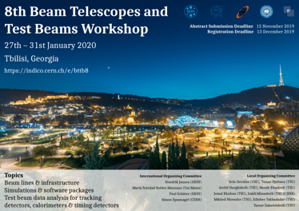Speaker
Description
A key point in the design stage of a HEP tracking detector is to minimize the amount of material and therefore radiation lengths (X$_0$) associated with the detector. The values for simple and bare materials are available in tables, but more complex material compounds, such as adhesives or composite materials, are often not directly available and only estimations exist.
The method of material budget imaging (MBI) enables to perform a direct measurement of the material budget $\epsilon=X/$X$_0$ as input for calculations or simulations of detector performance and behavior.
For this, electrons with energies between 1 and 5 GeV from the DESY testbeam traversing the inserted device, the scatterer under test (SUT), will be scattered inside the material. The amount of scattering is dependent on the radiation lengths traversed. By using the provided EUDET-type beam telescopes it is possible to reconstruct the particle tracks with high spatial and angular resolution and to evaluate the angular scattering distribution.
The reconstruction of particle tracks is performed within the EUTelescope framework, using the General Broken Lines (GBL) track fitting algorithm. Finally, by applying theoretical scattering models, such as the Highland formula, the radiation length of the material can be extracted.
For a routinely use of the MBI method for testbeam users at DESY, a calibration with a large variety of known scattering materials as well as different measurement parameters (e.g. particle energy, telescope setup) is necessary. Moreover, the comparison of theoretical modelling for the extraction of the radiation length with the measured data allows to test corrections to these model predictions.
